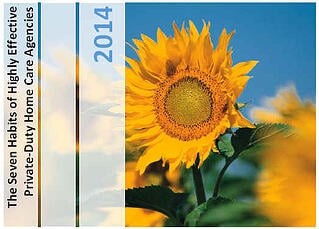Let's start today's blog post with a provocative statement:
"The adoption of Electronic Visit Verification (EVV) means that it will be the end of perfect time sheets"
How can this be? Shouldn't EVV give us better time sheets?
Great Questions! Here are the answers:
 Yes - Your time sheets will be more accurate, and hence better with EVV. However, they won't be quite as perfect. You see, if your caregiver is scheduled for a shift from 9:30 AM to 12:30 PM on Mondays, Wednesdays and Fridays, you are likely to receive a time sheet each week saying that your caregiver worked on Monday, Wednesday and Friday from 9:30 AM to 12:30 PM.
Yes - Your time sheets will be more accurate, and hence better with EVV. However, they won't be quite as perfect. You see, if your caregiver is scheduled for a shift from 9:30 AM to 12:30 PM on Mondays, Wednesdays and Fridays, you are likely to receive a time sheet each week saying that your caregiver worked on Monday, Wednesday and Friday from 9:30 AM to 12:30 PM.
The reality is likely to be somewhat different. Perhaps on Monday traffic was good and your caregiver arrived at 9:22, but on Wednesday she got a late start and didn't arrive until 9:41. But then again, on Monday she stayed all the way until noon even though she got there 8 minutes early, so on Wednesday she figures she can leave on time at noon and it will all be fine.
Managed Care Programs require perfect accuracy in your time sheets
For the purpose of this blog article, we'll define managed care programs as programs where there are specifically authorized amounts of time for care, that are based on a set of tasks that have been assessed to be needed by the care recipient. These programs, often funded by Medicaid, require accurate time sheets measured by EVV systems. As we established above, your time sheets will look less "perfect" with EVV meaning that your caregivers will rarely arrive and leave exactly at the scheduled time. As such, and since the majority of these programs require you to bill 15 minute units of care, you will need to comply with the appropriate rounding rules imposed by your program and your state.
Rounding may be different for Billing than it is for Payroll
Rounding rules for Billing are most likely to be defined by the managed care payer (e.g., the Medicaid, VA or other payer who has authorized the service). Note that if you are providing services that are paid privately (e.g., by the payer or their family) then you can typically define your rounding rule as you see fit (and perhaps as required due to competition).
By contrast, rounding rules for payroll are most likely defined by the Department of Labor (DoL) and may also vary from state to state.
The Typical Rounding Rules:
The most common rounding rules that you'll need to support are as follows:
- Round Down: For example, if a caregiver works 55 minutes, and you can only bill for completed 15 minute units of care, then you'd have to round down, and in this case bill for 45 minutes (3 units) of care.
- Round Up: If you are permitted to round up, then a 55 minute visit and even a 46 minute visit would be rounded up to a full hour. This rounding rule is hardly ever used in managed care (in fact I've never seen it)
- Round to Nearest: Rounding to the nearest 15 minutes is a rule that is permitted by some programs. They rationalize that sometimes you'll be rounding up and will be paid for an extra few minutes, whereas other times you'll be rounding down and it will all pretty much even out over time. The "round to the nearest" rule is often called the "rule of seven eighths" meaning that if you are over by 7 minutes or fewer you round down and if you are over by 8 minutes or more you round up.
- No Rounding: As it's name implies, no rounding means that you don't round. This is typically the way that labor laws want you to handle rounding. You pay the caregiver for every minute that they work (whether you're able to bill for it or not).
Special Processing Helps:
There are some cases where a little bit of extra processing can help your EVV efforts. Here are a few of the special processes that we offer in Ankota to help with EVV:
- Letting the Caregiver Know when to clock out: In most cases it's the duration of the visit that matters, so if a caregiver clocks in 7 minutes late or 3 minutes early, we can tell them through voice telephony or the mobile app when they should clock out. We also let them know when they're trying to clock out early (to encourage them to complete their whole shift)
- Accumulated (aka Accrued) Minutes: Some states such as Missouri require you to round down for billing and to pay for all minutes worked, but they also let you keep track of those extra minutes and when the same caregiver crosses a 15 minute threshold of care for the same client and the same service, you can bill an additional unit.
- Titration: Often states provide an authorization that corresponds to a 31 day month. For example, if they would like you to provide care 7 days a week for 2 hours a day, they'll authorize 62 hours (or 248 15 minute units). But in a typical month it's unlikely that service will be delivered exactly in accordance with that plan. For example, it may be a 30 day month or a 28 day month or the client might not need care on some days because they are with family. Titration is a process that spreads the unused units onto different days so that the client can receive all of the care that they're authorized for.
Successful Agencies will be ready for managed care
The future of home care will largely require care to be delivered in accordance with authorizations. Even if you mostly serve affluent private pay clients today, if you want referrals from health systems who are engaging you for population health management, you'll need to be ready for managed care.
Learn More About Managed Care
Ankota's team has managed care experience dating back to the 1990s. If we can help you prepare for the managed care future of home care, please contact us.
---
Ankota provides software to improve the delivery of care outside the hospital, focusing on efficiency and care coordination. Ankota's primary focus is on Care Transitions for Readmission avoidance and on management of Private Duty non-medical home care. To learn more, please visit www.ankota.com or contact us.





Your Comments :